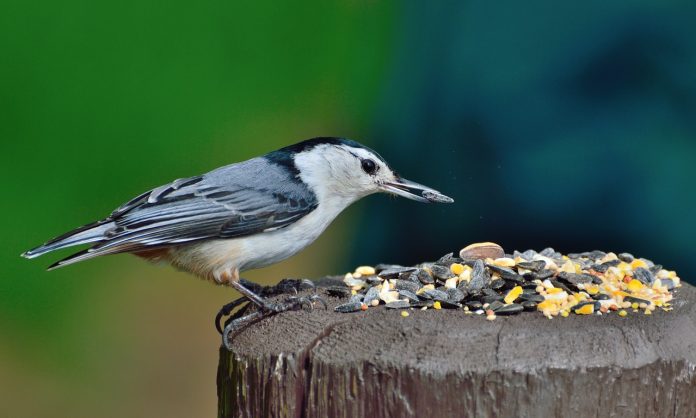Mixed flocks of gregarious, acrobatic, arboreal (tree-dwelling) birds frequent feeders during the fall and winter.
Chickadees, titmice, nuthatches, creepers and woodpeckers make up the group of birds I call the “social climbers.”
Offer suet and sunflower seeds and learn to identify this fascinating group of feeder birds.
The first characteristic to notice is relative size.
Chickadees
At about 5 inches long, chickadees (0.4 ounces) are small, plump, gray birds with contrasting black caps and black throats.
Flock size varies from four to a dozen individuals. Their most common call note is a distinctive, “chick-a-dee-dee-dee.”
If you live in the mountains or north of an imaginary line from Philadelphia to Kansas, you probably see black-capped chickadees.
At lower elevations and south of that line, Carolina chickadees predominate.
Titmice
Tufted titmice (0.75 ounces) are also small gray birds, but are larger than chickadees. The most distinguishing characteristics are the prominent crest on the head and black forehead.
In fact, titmice are the only gray crested bird in this part of the country. In flight, you might notice a rusty wash on the sides under the wings.
Their call suggests a chickadee’s, but faster. Titmice flocks usually number four to six individuals.
Nuthatches
White-breasted nuthatches (0.75 ounces) are the most acrobatic of the social climbers. They scurry head first down tree trunks with ease and often spiral around branches as they forage for insect eggs and pupae. They are about the size of titmice, wear a black cap, and have a pure white face. Females are similar, but paler and duller.
The bill is dagger-like. Observant watchers will notice a rusty wash on the sides.
I usually see nuthatches in pairs and hear their nasal “yank, yank” call note.
Some years, red-breasted nuthatches (0.35 ounces) invade from the north. Early reports indicate that this could be a big red-breasted nuthatch invasion winter.
Red-breasts are easy to recognize as nuthatches but are smaller than white-breasts. The rusty breast is distinctive, and their voice sounds like a toy horn.
They are also fearless and can sometimes be tempted to feed from an outstretched hand.
Creepers
Brown creepers (0.3 ounces) are a bit smaller than chickadees, cryptically colored, and can be difficult to spot. The bill is thin and decurved.
The rusty rump can be seen in flight. Creepers spiral up from the base of trees then fly down to a lower spot on another tree. They love suet and peanut butter, but only occasionally visit feeders.
Woodpeckers
The final members of the social climbers are the woodpeckers, which usually join these flocks as singles or pairs. Woodpeckers hitch their way up tree trunks using their tail as a prop.
They peel off bark or hammer through wood in search of insect food. In flight, they bounce through the air in an undulating motion. And they often communicate by drumming on hollow trees.
The most common and widespread woodpecker is the downy (1 ounce). It is just a bit larger than a titmouse and is black and white.
Adult males have a bright red spot on the back of their heads. Females lack this red spot.
A downy woodpecker’s bill is small, shorter than the length of its head.
Its voice is a sharp, high-pitched “pick!.” Downy woodpeckers are easily confused with hairy woodpeckers (2.3 ounces), but hairies are noticeably larger, and their bill is heavier and longer then its head.
See a downy and hairy side by side, and you’ll never again confuse the two.
The difference in relative bill size is obvious. Red-bellied woodpeckers (2.2 ounces) also frequently visit feeders.
This misleadingly named woodpecker has just a pale rosy wash on its belly, but its back is marked by horizontal black and white bars, it has a stout chisel-like bill, and the top of the head is red.
On males, the entire crown and back of the neck is red; on females, only the nape of the neck is red. I describe its voice as a “chuckle.” As you monitor feeders this fall and winter, watch for acrobatic social climbers. A reasonable goal would be to learn to identify these entertaining feeder birds by Christmas.














Pics would be great with name of birds, to easily identify!!